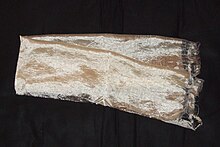Khata
| Khata | |||||||||
|---|---|---|---|---|---|---|---|---|---|
 A Tibetan khata | |||||||||
| Tibetan name | |||||||||
| Tibetan | ཁ་བཏགས་ | ||||||||
| |||||||||
| Mongolian name | |||||||||
| Mongolian Cyrillic | хадаг | ||||||||
| Hindi name | |||||||||
| Hindi | खतक | ||||||||

A khata or khatag[1][a] also (Khada) is a traditional ceremonial scarf in Tibetan Buddhism and in tengerism.[5][better source needed] It is widely used by the Tibetan, Nepali, Hindustani Gorkha, Bhutanese and Lepcha people in various occasions. It originated in Tibetan culture[citation needed] and is common in cultures and countries where Tibetan Buddhism is practiced or has strong influence. The practice of using khatas has influenced people of other communities too who are in close relation to these communities. It is predominantly used in Tibet, Bhutan, Nepal, and India other parts of the world. It is a symbol of honour and respect. It is used in Tibetan religious ceremony, ceremonial and traditional dances of etc., It is offered in monasteries and temples. It holds religious and cultural significance.
History[edit]
Tibetan people used to give animal skins as gifts because there was no silk in Tibet. According to the Bon historical record, people would put sheep wool around their necks during the time of the ninth king, Degong Jayshi, and head for some religious rituals. This tradition was passed down from that moment onwards. People began making scarves and using silk over time. So, the scarf replaced the plain sheep's wool and people put scarves on the neck and head.
Uses and types[edit]
The khata symbolizes purity and compassion and is worn or presented with incense at many ceremonial occasions, including births, weddings, funerals, graduations and the arrival or departure of guests. When given as a farewell gesture it symbolizes a safe journey. When given to arriving guests it symbolizes welcome. They were usually made of silk but now much more commonly cotton or polyester. Tibetan khatas are usually white, symbolising the pure heart of the giver,[6] though it is quite common to find yellow-gold khata as well. Tibetan, Nepali, and Bhutanese khatas feature the ashtamangala. There are also special multi-colored khatas. Mongolian khatas are usually blue, symbolizing the blue sky. In Mongolia, khatas are also often tied to ovoos, suvargas, or special trees and rocks.

Explanatory notes[edit]
References[edit]
- ^ Das, Sarat Chandra (1902). Rockhill., William Woodville (ed.). Journey to Lhasa and Central Tibet. London: Royal Geographical Society. p. 32. OCLC 557688339.
... handing him a scarf (khatag), I expressed the hope that we might meet next year.
- ^ 现代汉语词典(第七版) [A Dictionary of Current Chinese (Seventh Edition).]. 北京. Beijing: 商务印书馆. The Commercial Press. 1 September 2016. p. 505. ISBN 978-7-100-12450-8.
【哈达】 hǎdá
- ^ 现代汉语规范词典(第3版) [A Standard Dictionary of Current Chinese (Third Edition).]. 北京. Beijing: 外语教学与研究出版社. Foreign Language Teaching and Research Press. May 2014. p. 507. ISBN 978-7-513-54562-4.
【哈达】 hǎdá
- ^ "教育部《重編國語辭典修訂本》2021".
- ^ "The Eternal Blue Sky" (PDF). Hoop. 2014. Retrieved 2016-06-19.
- ^ Staff. "Khata/Tibet "roof of the world"". Oracle ThinkQuest Education Foundation. Retrieved 2010-02-04.
External links[edit]
 Media related to Khata / Haddak at Wikimedia Commons
Media related to Khata / Haddak at Wikimedia Commons


 French
French Deutsch
Deutsch